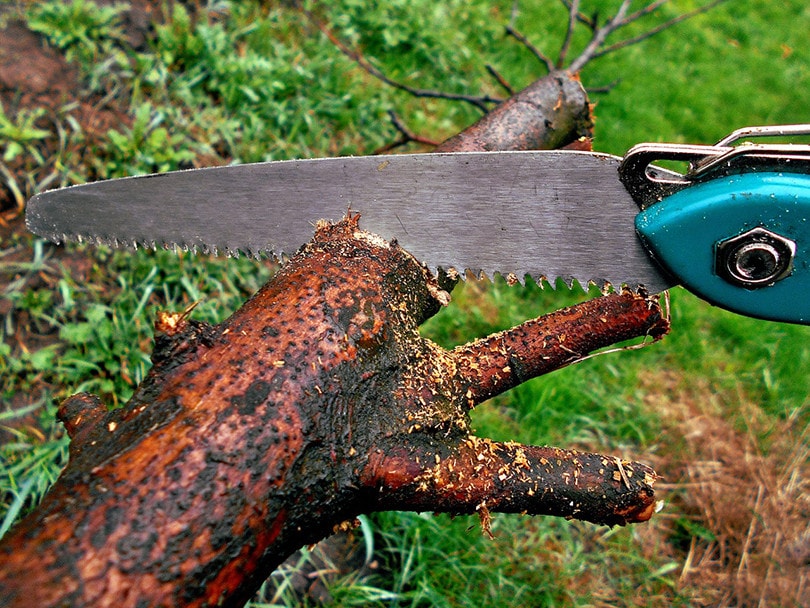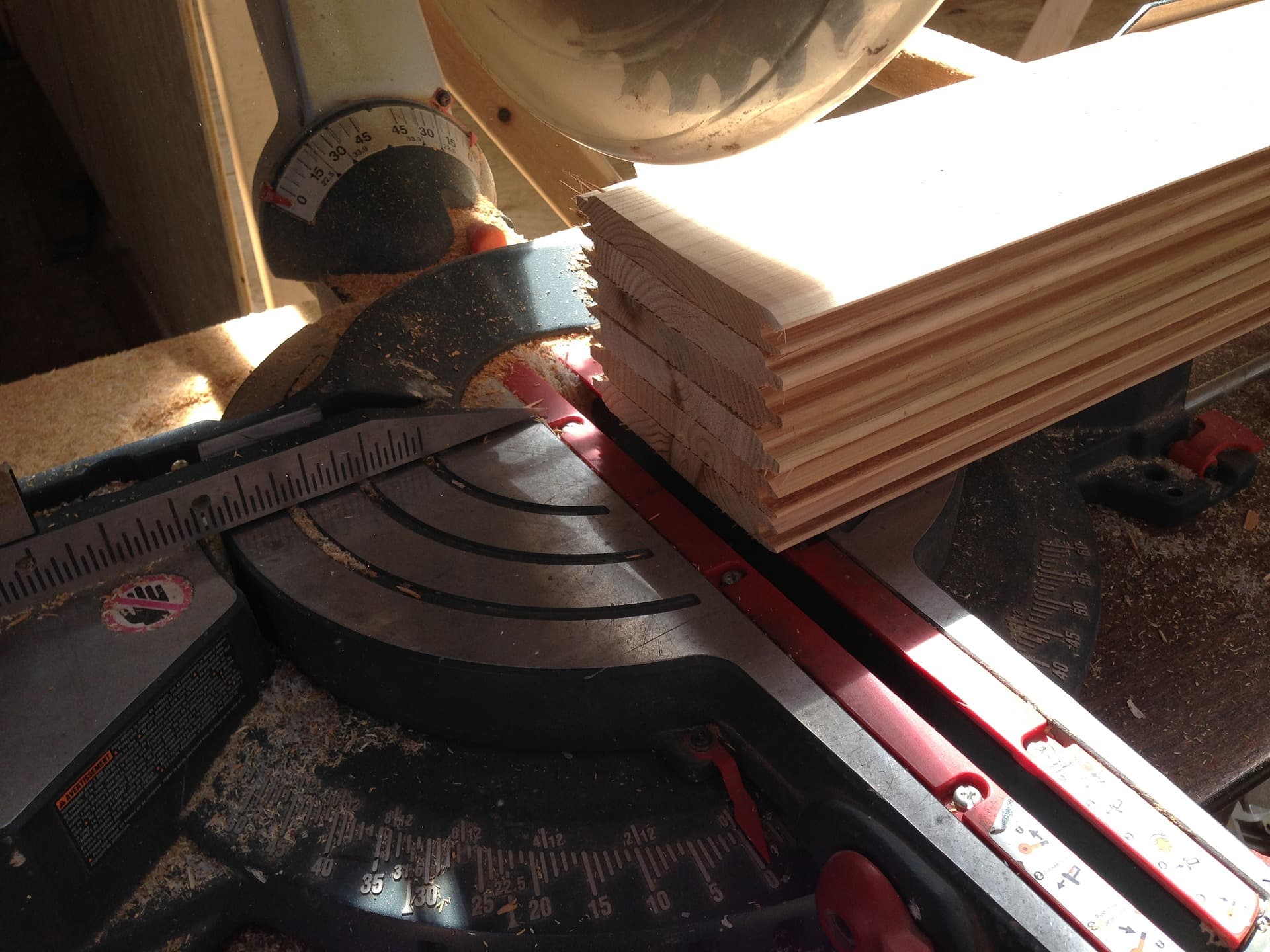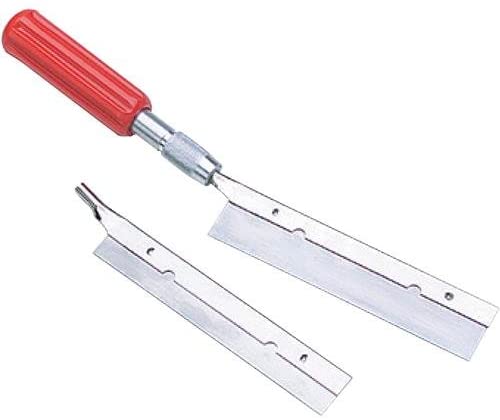38 Types Of Saws For Wood (With Pictures)
-
Pete Ortiz
- Last updated:

Saws, in general, are a hand or power tool that are used to cut through different materials. There are those that are designed specifically for cutting through metal and even saws that will make quick work of plastic and plastic tubes. There is also a massive selection of saws for cutting through wood, including handsaws, two-person saws, and power saws. Some are static and meant for attachment to a workbench and others are so portable that you can carry them around the garden while pruning and cutting.
Below are 38 types of saw used for cutting wood. Some of them you may have used yourself while others have such specific uses that you will likely never need them unless you’re a professional tree feller or specialist joiner.
The 38 Types of Saw for Wood
Manual Saws
1. Hand Saw

The hand saw is the basic workhorse of the wood saw world. It has a long blade and teeth that are slightly offset and there are different types of hand saw available depending on the task at hand.
2. Bow Saw
The bow saw has a light handle and a thin, narrow blade that connects to either end of the bow handle. The blade can be turned to any angle, which makes it possible to cut curves and to get into difficult spots.
3. Carcass Saw
The carcass saw is used for cutting the carcass of cabinets and furniture. It has a stiff blade, which offers precision, while the cut of the teeth makes it suitable for cutting across the grain. This is a specialized saw that is only really used in professional cabinetry.
4. Coping Saw
The coping saw has a narrow, thin blade that is pulled tight by the frame of the saw. The blade has sharp teeth and because it can be rotated and fixed at any desired angle, the coping saw is often used for cutting precise curves.
5. Crosscut Saw
The crosscut saw is a giant, manual saw that is operated by two people, one at either end. This may also be known by the name lumberjack saw, although it can also be used to cut planks to length.
6. Folding Saw
The folding saw is a convenient, lightweight tool that doesn’t serve a specific purpose but can be used for many jobs. When not in use, the blade folds into the handle, so it can be carried in a pocket, in a bag, or while you’re out camping or hiking.
7. Fret Saw
The fret saw is similar to that of a bow saw but with a much deeper frame and shorter blade. It is used for cutting curves and its design means that it is suitable for very precise and tight cutting.
8. Japanese Saw
The Japanese saw is unique in that it is designed to cut as you pull back rather than when you push forward. This means a thinner blade and it causes less tearing of the workpiece when cutting.
9. Keyhole Saw
Although most often used for drywall, a keyhole saw does have utility as a wood saw. It has a sharp point at the end of the blade, and the blade gets thicker towards the handle. This allows you to create a start hole in the workpiece and then to saw out from the pilot hole.
10. Pocket Chainsaw
A chainsaw uses a chain as the blade and is typically powered by a gas or electric motor. The pocket chainsaw has the same chain blade but is operated manually and has a handle on either end of the chain blade.
11. Pole Saw
The pole saw is most often used for pruning trees and tall shrubs. It has a long pole handle with a blade firmly attached to the end. A manual pole saw requires a lot of effort, sawing at full stretch, but there are power and motorized versions available.
12. Pruning Saw
The pruning saw is used for pruning branches, twigs, and vines. They have a curved handle and blade, a dense row of teeth that should make relatively easy work out of most trees, and they are a very convenient tool for the avid gardener.
13. Razor Saw
The razor saw is really only used for very soft woods and finds utility in model making and other precision work. It has very fine teeth that would scarcely work on hardwood and they prevent the damage that larger teeth would make of delicate workpieces.
14. Rip Cut Saw
The rip cut saw is designed specifically to cut with the grain of the wood and not across the grain. It has a long, flexible blade, so is not ideally suited to precision work but its tooth design will cut with every push and pull.
15. Tenon Saw

The tenon saw, or back saw, has fine teeth and is designed so that the blade stays straight and unflexible. This lends itself to precision cutting and the tenon saw is used, amongst other things, for cutting tenon joints.
16. Veneer Saw
The veneer saw is one tool that you won’t need except in very specific circumstances. Its narrow blade and offset handle, as well as its double-edged blade, make it possible to cut thin hardwood veneer completely flush to the surface.
17. Wire Saw
A wire saw is similar to the pocket chainsaw, except it uses a wire blade rather than a chain. Rather than cutting the wood, a wire saw essentially rubs the wood down. The wire saw is portable and convenient, but it can be challenging on the hands and fingers.
 Power Saws
Power Saws
18. Band Saw

The band saw is another saw that relies on abrasion rather than cutting, but it is powered, rather than manual. The band is driven by wheels and, although it is not known for making precise cuts the band saw is popular for its safety and lack of kickbacks.
19. Biscuit Joiner
A biscuit joiner is really more than just a saw, but it does include a sawing mechanism. It cuts holes in two pieces of wood. A wooden slither, called a biscuit, is then glued and inserted in the holes to connect the two workpieces. This is the biscuit joiner’s only function.
20. Chain Beam Saw
The chain beam saw is another saw with a very specific use. It combines the movement of a circular saw with the cutting of a chainsaw to make cutting timber frames and logs quicker and easier.
21. Chainsaw

If you have a lot of trees in your yard, you may already have a chainsaw because it is used to cut down entire trees and to easily saw off limbs and branches. It can be powered by battery or have a gas motor.
22. Chop Saw
Chop saws can be used for woodworking and are a stationary saw that chops up and down. The blade cannot be moved, although the workpiece can be placed and cut at an angle in some cases. Woodworkers generally prefer the flexibility of a miter saw.
Related Read: Chop Saw vs. Band Saw For Metal: Pros, Cons, and FAQ
23. Circular Saw
The circular saw is a handheld, powered saw. It has a circular blade that makes quick work of wood, and the blade can be changed so that the saw can be used with metal and other materials.
24. Compound Miter Saw
A compound miter saw is an even more flexible alternative to the miter saw and is frequently used in cutting trim. The blade and head can be tilted and angled, allowing for bevel as well as compound, cross, and miter cuts.
25. Domino Joiner
Like the biscuit joiner, the domino joiner does more than just saw and has a very specific purpose. It cuts mortises ready for the connection to tenon joints. You’ll never want one, unless you need one.
26. Electric Hand Saw

The electric hand saw is a powered version of the hand saw. The electric power essentially forces the blade back and forth, mimicking the sawing motion, but these are not popular with DIYers or professionals and there are better alternatives in this list.
27. Flooring Saw
The flooring saw can be used to cut flooring and has a degree of portability that means it can be taken to the worksite with you. It lacks the precision of a table saw but does offer the convenience of mobility.
28. Jamb Saw
The jamb saw makes it possible to cut out a very small section of door jamb so that flooring can be laid completely flush with the wall. It’s a very specialist tool but it does have its purpose.
29. Jigsaw
The jigsaw is a popular power saw with professionals and DIYers. It has a very thin blade, which can be moved and turned around a template or outline so it can be used to make a great range of cuts, although is usually not suitable for thick wood or very straight lines, without a guide.
30. Miter Saw

The miter saw is a table saw that includes boxes and guides so that you can cut angled miter joints on the butt of wood pieces. It is not as versatile as a compound miter saw but a lot more functional than a chop saw.
31. Oscillating Saw
The oscillating saw has become a very popular addition to the home toolbag. It is small, lightweight, and it can perform a variety of tasks. It can also get into spaces that a lot of other power saws cannot reach.
32. Panel Saw
The panel saw is a massive saw that lives in the workshop and is used to cut large sheets or panels of wood to very precise measurements. It is unlikely that you will have or want one of these in your home workshop.
33. Radial Arm Saw
You can still find radial arm saw models, but miter saws are preferred in most cases. The radial arm saw lost favor because it was considered quite unsafe for use.
34. Reciprocating Saw
The reciprocating saw is similar in design and function to a jigsaw, except that the handle has been turned and the saw is used in vertical orientation.
35. Scroll Saw

Scroll saws have fine blades and are used for precise cuts. Traditionally used for sawing scrollwork, the scroll saw is still used in the production of fine wooden furniture and detail.
36. Straight Flush Saw
The straight flush saw is a circular saw but it has a recessed blade mounting point so that it can cut flush against other surfaces. It can be used to cut studs and frames so that they are perfectly flush.
37. Table Saw
The table saw is found in workshops, including amateur workshops. It has a circular blade and multiple guides and blocks to allow for fast and precise cutting.
38. Track Saw
The track saw is another type of circular saw. This one has a track guide attached to a handheld circular saw. It can be used to make precise cuts at a desired depth.
 Conclusion
Conclusion
Getting the right saw can make the job easier and simpler, and with a such a huge variety of wood saws available, you are virtually guaranteed to find one that is perfectly matched to the job at hand, whatever that might be.
Featured Image Credit: JerzyGorecki, Pixabay
Contents









